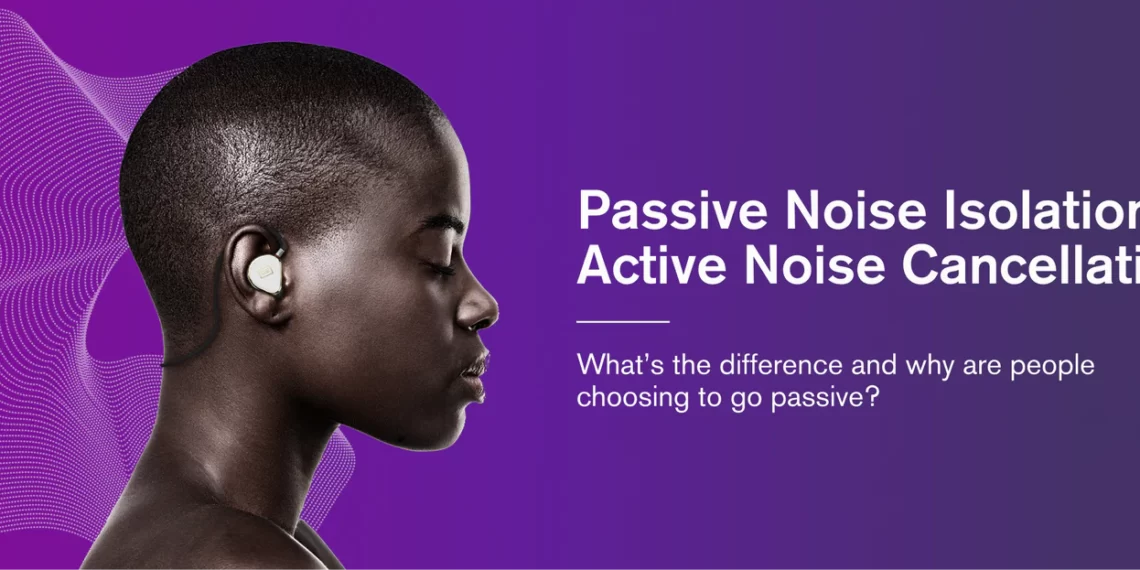What’s the difference between passive noise isolation and active noise cancellation?
When you’re shopping for earbuds, there are a lot of terms you see over and over. Two of those terms are passive noise isolation and active noise cancellation. If you’re not sure what the difference is between the two, you’re not alone.
Though the goal of both is to block outside noise so that you can enjoy your music with fewer distractions, passive noise isolation—also called passive noise cancellation (PNC)— and active noise cancellation (ANC) couldn’t be more different.
In this article, we’ll explain the differences between passive noise isolation and ANC in terms of comfort, sound quality, ambient noise reduction and more.
What is passive noise cancellation?
Passive noise isolation (PNI) or cancellation is when your headphones, earbuds, earphones, or in-ear monitors naturally block outside noise. In other words, your earbuds are isolating you from ambient noise instead of actively using technology to cancel it out. That’s why you’ll hear this technique called both passive noise isolation and passive noise cancellation.
When your earbuds are molded to the exact shape of your ears, it prevents outside ambient noise from entering your ear canal. That means you can listen to music at lower volume levels because you don’t have to counteract the sounds of your environment—whether that’s a noisy coffee shop or the loud rumble of a plane engine.
You don’t need additional battery power to take advantage of passive noise isolation. All earbuds and headphones have some degree of passive noise isolation, but custom-fitted earphones, in-ear monitors and earbuds are by far the best in this regard, as they create a comfortable and secure seal.

What is active noise cancellation?
Active noise cancellation is when your headphones or earbuds neutralize the ambient noise around you via noise-cancelling technology. They work by incorporating microphones into your headphones, which listen to the outside noise and generate a phase-inverted sound that effectively cancels out ambient noise before it reaches your ears. In other words, ANC cancels noise by creating equal but opposite noise.
Unlike passive noise isolation, you have to charge all ANC headphones and earphones to take advantage of active noise cancellation. If you have earbuds or headphones that have optional ANC, you’ll notice that the battery doesn’t last as long when the ANC is on.
ANC is relatively easy to implement in earbuds and headphones. It’s a popular way for earbud manufacturers to offer some level of noise reduction without customizing the actual fit of their products.
Is active noise cancellation harmful?
Active noise cancellation isn’t harmful. There are no threats to your hearing with ANC headphones. There’s also no radiation or harmful waves involved in ANC technology.
However, some people have reported feeling dizzy from ANC headphones. Doctor Sarah Stackpole from the Wall Street Journal speculates that low-frequency signals used in ANC headphones may trick the brain into thinking that the body is moving, even though your eyes don’t detect motion at all. The difference between what your body feels and what your eyes see can cause mild dizziness in some.
There’s also the phenomena some experience called “eardrum suck,” which is when people who are using ANC headphones feel a change in pressure similar to being on a plane changing altitudes.
Audio engineer Brent Butterworth spoke to another engineer who requested to remain anonymous about the cause of ear drum suck and was told the issue is psychosomatic. “There’s no actual pressure change. It’s caused by a disruption in the balance of sound you’re used to hearing … People sometimes report the same effect when they go into anechoic chambers, which absorb high frequencies but allow low frequencies to come through. With noise-canceling headphones, it’s the opposite—you’re canceling the bass but not the high frequencies—but it can have the same effect.”
In other words, some music lovers may simply be more sensitive to ANC, but it’s not harmful.
Passive noise isolation vs. active noise cancellation
Now that you know the difference between passive noise isolation and active noise cancellation, you might be wondering which one suits you better. Here are a few questions we’ve heard about passive noise isolation vs. active noise cancellation.
Which has better sound quality?
If you’re comparing two sets of earbuds with similar build and tuning quality, the earbuds with better passive noise isolation typically sound more pure than the ones that rely on active noise cancellation to block out ambient noise.
The reason passive noise isolation sounds more pure is because ANC earphones and headphones create noise to cancel environmental sounds. This effectively adds mild distortion to your music. Passive noise isolation results in a truer representation of your music while blocking outside noise. Will ANC ruin your music for you? No, but you may have a sense of something “missing” from the mix.
PNI is trusted by musicians and music purists because it blocks ambient noise without adding noise or distortion.

Which is more comfortable?
Passive noise isolation is best achieved through custom-molded and custom-fitted earbuds and earphones. Earbuds and headphones with active noise cancellation typically aren’t custom-fitted to your unique ears. That means your ANC earbuds might fatigue your ears more quickly because you’re putting pressure on certain parts of your ear more than others.
Custom-fitted earbuds will be more comfortable to keep in all day. That’s because earbuds like UE FITS form to fit your unique ears, so you won’t find your ears aching from pressure being unevenly distributed.
How effective is passive noise cancellation?
Passive noise cancellation and active noise cancellation both do a great job of reducing outside noise. However, each has its strengths and weaknesses depending on the range of the frequencies being blocked.
Earbuds with passive noise cancellation can lessen mid- to high-frequency noises by about 15dB to 30dB. Meanwhile, active noise-canceling headphones and earbuds work better to reduce lower frequencies. That makes sense considering the technology was originally used for airline and helicopter pilots who deal with more low-frequency noise on a daily basis—not everyday music fans. ANC can cut ambient noise overall by an average of 30dB, while low frequency noise generated by lawnmowers, subway traffic and airplanes can be reduced by as much as 60dB.
In other words, earbuds with passive noise isolation reduce mid-high frequencies better while ANC does better with low frequencies.
Another thing to consider in regards to reducing outside noise is that ANC headphones work best at reducing constant background noise, not sudden transient noises. Sudden noises, like a car honking its horn outside your coffee shop, occur too quickly for your ANC headphones to detect and combat these sudden sounds.
Meanwhile, passive noise isolation reduces all incoming sound by roughly the same amount. So ANC headphones won’t block out that car horn at all, but your custom-fit earbuds will reduce it as much as they reduce constant noise.
Which is safer for your hearing?
Passive noise isolation and active noise cancellation are both safe to use. Assuming you’re listening at a safe volume level, you won’t need to worry about hearing loss. In fact, both methods can help you protect your hearing by allowing you to listen to music without blasting the volume.
Which consumes more power?
Even if your passive noise isolation earbuds use Bluetooth to operate, they’re still consuming less power than Bluetooth earbuds with active noise cancellation.
Earbuds and headphones with ANC require power to create the noise that cancels ambient sounds before they hit your ears. However, products like UE FITS only need power for the Bluetooth. That results in longer battery life, other elements considered.
There are also earphones and in-ears like our UE Professional series that don’t use any power at all. With those options, you can enjoy high-fidelity sound and passive noise isolation without ever having to wonder if you remembered to charge them before boarding that six-hour flight.
Which is more affordable?
The cost of earbuds and earphones can vary dramatically depending on the brand. You can find earbuds with passive noise isolation or active noise cancellation for as little as $50, but the sound and build quality might be dubious.
When you compare a product like UE FITS to earbuds with ANC that offer high audio quality, you’ll find that the prices are comparable between passive noise isolation and active noise cancellation. FITS are just $199, which is in line with ANC offerings from other reputable brands. However, no other off-the-shelf earbud brand offers customization for stellar passive noise isolation in 60 seconds the way UE FITS does.
Which is better when you’re not listening to music?
If all you want to do with your earbuds is block out ambient noise, active noise cancelling earbuds are a fine solution, especially if you want to block out low frequencies. ANC earbuds can block out up to 60dB of lower frequencies, like sounds from subway trains. Keep in mind that not all ANC earbuds may not be completely noise-free when you’re not playing music—you may still hear a gentle hiss.
If you want to keep earbuds in even when you’re not listening to music, custom-fitted earbuds like UE FITS will be comfortable to keep in all day. That’s because earbuds like FITS form to fit the unique contours of your ears, so you won’t find your ears aching from pressure being unevenly distributed.
Which is more portable?
When it comes to earbuds, models with passive noise isolation are often the same size as those with active noise cancellation. However, portability varies by brand and model of earbuds.







